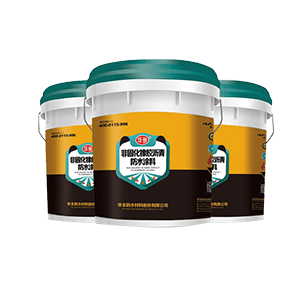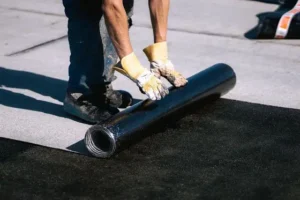Selecting appropriate waterproofing solutions is important in preventing water-related damage to structures. Huafeng Waterproof Materials Co., Ltd, a leading industry manufacturer, offers recommendations on modern technologies and practices applicable for various waterproofing solutions.
1. Coating-Based Waterproofing
Coating based waterproofing systems are executed through forming a continuous membrane layer over the substrate coating waterproofing. All known acrylic, polyurethane and cementitious coatings fall under this category. Let us delve deeper into one of the most widely used waterproofing methods—acrylic waterproof coatings:
Key Advantages:
-
Substrate Adaptability: Its liquid nature allows it to perfectly cover complex structures like pipe roots and corners, creating a seamless film.
-
Eco-Friendly: Being water-based, acrylic coatings have low VOC emissions and no solvent odor, making indoor application safe.
-
Easy Repair: Local leaks can be repaired specifically without needing to redo the entire layer.
-
User-Friendly: Ready-to-use straight from the can, applicable by brush or roller, ideal for DIY projects.
Main Drawbacks:
-
Limited Weather Resistance: Acrylic coatings can chalk and degrade under UV exposure or continuous rain, requiring reapplication every 3-5 years if exposed.
-
Dependence on Application Thickness: Multiple layers (typically 2-3) are necessary, with proper drying times critical for performance.
-
Lower Mechanical Strength: Acrylic coatings are less resistant to punctures than membrane sheets and require roughening the surface before tile installation to improve adhesion.
Popular Types of Coatings:
-
Acrylic
-
Single-component polyurethane
-
Elastic cementitious coatings
-
Crystalline penetrating coatings
| Material/Coating | Elasticity | Durability | Ease of Application | Typical Applications | Cost | Notes |
|---|---|---|---|---|---|---|
| Acrylic Fiber | Medium Elasticity | Good | Easy | Interior/exterior walls, protective layers | Moderate | UV resistant, good weatherability |
| Single-component Polyurethane | High Elasticity | Excellent | Easy | Waterproofing, corrosion protection, sealing | High | Flexible, strong chemical resistance |
| Elastic Cement-based Coating | High Elasticity | Good | Moderate to Difficult | Concrete, structural repair | Moderate | Combines cement strength and elasticity |
| Crystalline Penetrating Coating | Low Elasticity | Excellent | Moderate | Concrete waterproofing and corrosion protection | Moderate | Penetrates to form dense protective layer |
2. Polypropylene Fiber Fabric Waterproofing
This method uses polypropylene non-woven fabric laminated with polyethylene membrane as a roll material, adhered with cement glue.
Significant Advantages:
-
Immediate Waterproofing: Forms a waterproof layer instantly after installation without curing time.
-
Chemical Resistance: Resistant to acids, alkalis, and salts, suitable for basements and chemical environments.
-
Moist Substrate Application: Can be applied on substrates without visible free water, making it ideal during rainy seasons.
Critical Limitations:
-
Poor Heat Resistance: Deforms permanently above 80°C, which is problematic for rooftops reaching temperatures of 70°C or higher, causing adhesion failure.
-
Fast Aging: Becomes brittle and chalks within 1-2 years under UV exposure, strictly prohibited for exposed use.
-
Difficult Detailing: Pipe joints and corners require heat welding reinforcement, which has a high failure rate.
Suitable Applications:
-
Non-exposed, non-high-temperature zones such as basement slabs (avoiding direct sunlight)
-
Indoor wall damp-proofing layers (covered by wall tiles)
-
Temporary waterproofing for construction

3. Membrane Waterproofing Solutions
This includes synthetic polymer sheets like SBS-modified bitumen, PVC, and TPO membranes, applied by heat welding or self-adhesion.
Core Advantages:
-
Efficient Installation: Mechanical laying can cover up to 500㎡ per day, shortening project duration by about 60% compared to coatings.
-
Uniform Thickness: Pre-manufactured membranes (typically 2-4mm) ensure consistent thickness, preventing shortcuts.
-
Strong Weather Resistance: SBS-modified bitumen membranes withstand temperatures from -25°C to 100°C, allowing up to 10 years of outdoor exposure.
Main Drawbacks:
-
Seam Leakage Risk: Overlapping seams ≥10cm must be carefully treated; improper handling causes 75% of leaks.
-
Strict Substrate Requirements: Requires flat, solid bases; bubbles or cracks can tear membranes.
- Repair Challenges: Leak points are hard to locate, often requiring full membrane replacement.
Types Comparison:
-
Self-adhesive Membranes: Easy to install but prone to sagging at high temperatures, suitable for non-horizontal surfaces.
-
Heat-welded Membranes: Stronger bonding but with fire risks during installation, preferred for critical projects.
4. Comprehensive Comparison and Selection Recommendations
| Waterproof Type | Advantages | Disadvantages | Best Use Cases |
|---|---|---|---|
| Coating (Acrylic, PU) | Seamless, eco-friendly, easy repairs | Limited UV resistance, multiple coats | Bathrooms, kitchens, DIY projects |
| Polypropylene Fabric | Immediate waterproofing, chemical-resistant | Poor heat resistance, hard to detail | Basement slabs, indoor damp-proofing |
| Membranes (SBS, PVC) | Fast, uniform, weather-resistant | Seam leakage, substrate strictness | Roofs, outdoor balconies, large projects |
Selection Golden Rules:
Roof and Exposed Balcony areas require SBS membranes (best weather resistance) or water-based polyurethane coatings suitable for exposure usage.
Bathrooms and Kitchens require flexible cementitious coatings or acrylic reinforced with fiberglass.
Basement Slabs need to use Polypropylene Fabric (cheaper option) or crystalline penetrating coatings (in case of water pressure).
Swimming Pools and Subways require single component polyurethane with high elongation.
Crack Repairs require self healing crystalline the materials.
Metal Roofs can be finished with water based ultra-durable polyurethane (color customizations available and adheres strongly).
Conclusion
With Huafeng Waterproof Materials Co., Ltd.’s expert guidance and reliable services, you can choose the ideal waterproofing solutions tailored to your project’s needs—ensuring long-lasting performance and peace of mind.
📞 Get in Touch with Our Experts Today – Let’s Build Something Waterproof, Together!
-
- Phone: +86 138 6365 6701
- Email: Huafengwaterproof@gmail.com
- WhatsApp: +86 138 6365 6701







